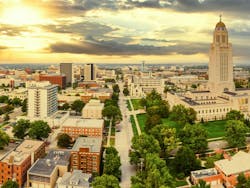A Ready-Made Microgrid at Zero Cost? Yep. A Nebraska Utility Did It
Lincoln Electric System (LES), the public power utility serving greater Lincoln, Nebraska has set up a microgrid with up to 29 MW of load to serve critical facilities.
The cost? Zero.
The microgrid in downtown Lincoln is based around an existing duel-fuel, 29-MW generating unit and a substation and its infrastructure, according to Scott Benson, LES manager of resource and transmission planning.
The project didn’t require any new equipment or a microgrid controller.
“It’s almost ready-made,” he said.
Model for other utilities
The LES microgrid, which became operable in October after key testing, could be a model for other utilities, Benson said. Some utilities may need to make upgrades to create a microgrid using their existing system, but they may already have ready-to-go or nearly complete microgrids, he said.
“We were sitting on this with a lot of load and generation in the same spot,” Benson said. “A lot of other utilities may be in a similar spot.”
The project serves key city, county and state facilities, including Nebraska’s Capitol as well as the Pinnacle Bank Arena, gas stations and a grocery store.
Along with the LES J Street generator, the microgrid is made up of five customer-sited solar facilities totaling about 300 kW and a 500-kW thermal energy storage system that can run for six hours before needing to be recharged.
The key to the microgrid is the J Street generator, which is able to follow load, according to Benson. The solar and energy storage that is part of the microgrid is handled as load and doesn’t need to be controlled, he said.
Multiyear planning
Planning for the project started in 2016 when LES noticed there was an opportunity to serve critical infrastructure in downtown Lincoln, Benson said. However, the utility dropped the plan when it decided it was too complicated to set up a grid to handle each individual building deemed to be critical.
LES revisited the idea two years later and decided to include all the load in the area, such as residential buildings instead of individual sites, he said. The shift removed the difficulties of switching over individual sites when going into island mode, he said.
To set up the microgrid, Benson said, LES drafted a “switching order” for going into island mode. The utility verified the J Street generator’s ability to run the microgrid using two 5-MW load banks, which are used to test power equipment.
The J Street generator, which runs on natural gas or fuel oil, is a peaking unit that runs during hot summer days when dispatched by the Southwest Power Pool, according to Benson. LES stores enough fuel oil at the plant to run at maximum capacity for 36 hours, he said. When the plant is operating in island mode, it can maintain the microgrid’s voltage and frequency when limited to load steps of up to 5 MW.
Looking ahead, LES plans to automate a substation where most of the load in the microgrid is supplied from, according to Benson.
Microgrid provides peace of mind
Lincoln is partly supplied by two power plants outside the city and is near major transmission lines.
The city has never had a major power outage, but the region experiences tornados, which can cause devastating damage to power systems, Benson said.
“You might go two decades and not need [the microgrid],” Benson said. “But if you need it, you know you’re on the national news.”
While many of the critical buildings in the microgrid have emergency generators, the microgrid will give them days of power, according to Benson.
The US Department of Energy is preparing a publication that highlights the J Street microgrid project as an example of how to use existing infrastructure to provide new community benefits, he said.
Track news about utility microgrids. Subscribe to the free Microgrid Knowledge Newsletter.
